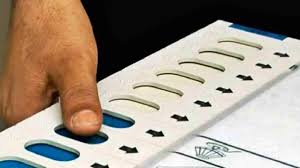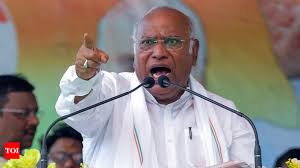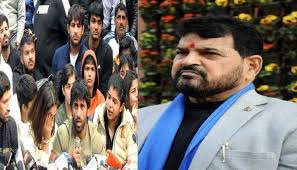
Low voting in the second phase also raised concerns
-Even less votes were cast in the first phase, only 63.00 percent voters cast their votes.
-After all, who will be affected by this trend?
New Delhi. In the second phase of Lok Sabha elections 2024, voting was held on 88 seats in 13 states and union territories on Friday. However, the enthusiasm about the elections was reduced by the voting percentage that came in the evening. This time the voting trend was worse than the first phase of elections. In the second phase, only 63.00 percent voters exercised their franchise, whereas in 2019, more than 70 percent people had voted in large numbers on the same seats. This decreasing voting percentage has spoiled the mathematics of all political parties.
In the first phase, 64 percent votes were cast on 102 Lok Sabha seats in 21 states. In the last elections, more than 70 percent voting took place on those seats also. The same situation remained in the second phase also. The voting figure could not cross 80 percent in any state.
Talking about the figures, highest number of voters exercised their franchise in Tripura at 78.6 percent and lowest in Uttar Pradesh at 54.8 percent. Whereas 77.2 percent in Manipur, 73.1 percent in Chhattisgarh, 71.8 percent in West Bengal, 70.8 in Assam, 71.6 in Jammu and Kashmir, 65.3 in Kerala, 67.3 in Karnataka, 63.9 in Rajasthan, 56.8 in Madhya Pradesh, 54.3 in Maharashtra and 54.3 in Bihar. 54.9 percent voters voted.
Due to low voting, political parties and Election Commission are also worried.
Along with political parties, the Election Commission has also become concerned about people not coming out of their homes to vote. Especially in Hindi speaking states, voters have become monotonous about voting. Earlier in 2014 and 2019, a good number of people had voted, but this time the same enthusiasm is not being seen among the voters.
Voting less in both phases in UP
Uttar Pradesh has the maximum number of 80 Lok Sabha seats, but the voters there do not seem to be enthusiastic about the elections. While 57 percent votes were cast in the first phase, only 54.8 percent people exercised their franchise in the second phase. Experts believe that it is very difficult to find out from this trend in whose favor more votes have been cast.
Even in Bihar, which is said to be election and politically alert, this time voters are looking quite dull regarding voting. While 48 percent people voted in the first phase, 54.9 percent voters exercised their franchise in the second phase. Many people are also linking the low voting percentage in Bihar to weather and migration.
Hot weather in North India is also the reason!
The weather temperature has increased significantly these days in entire North India. Heat wave and hot winds have disrupted people's lives. This is also being cited as a reason for people not coming out of their homes to vote. At the same time, the low voting percentage is being linked to the low activity of opposition parties in the elections. At the same time, in today's elections, more use of social media instead of physical campaigning is also reducing the voting trend.
Low turnout affects seats with low margins
Due to low voting percentage, it has a direct impact on seats with low margins. In 2019, there was close competition on 75 seats. In such a situation the result can tilt in any direction. Some experts say that the ruling parties can benefit from low voting, because people think that the government is doing good work and they do not want change. That's why they don't come out of the house to vote.
Chances of government change due to low voting trend?
Voting percentage has decreased in 5 out of the last 12 elections and the government has changed four times. In the 1980 elections, the voting percentage decreased and Congress formed the government by removing the Janata Party. In 1989, the Congress government lost due to falling vote percentage. Government was formed at the center under the leadership of BP Singh. Even in 1991, Congress returned to the center after a decline in voting. However, even after the decline in voting percentage in 1999, there was no change in power. Whereas in 2004, once again the opposition parties got the benefit of decline in voting.
-Even less votes were cast in the first phase, only 63.00 percent voters cast their votes.
-After all, who will be affected by this trend?
New Delhi. In the second phase of Lok Sabha elections 2024, voting was held on 88 seats in 13 states and union territories on Friday. However, the enthusiasm about the elections was reduced by the voting percentage that came in the evening. This time the voting trend was worse than the first phase of elections. In the second phase, only 63.00 percent voters exercised their franchise, whereas in 2019, more than 70 percent people had voted in large numbers on the same seats. This decreasing voting percentage has spoiled the mathematics of all political parties.
In the first phase, 64 percent votes were cast on 102 Lok Sabha seats in 21 states. In the last elections, more than 70 percent voting took place on those seats also. The same situation remained in the second phase also. The voting figure could not cross 80 percent in any state.
Talking about the figures, highest number of voters exercised their franchise in Tripura at 78.6 percent and lowest in Uttar Pradesh at 54.8 percent. Whereas 77.2 percent in Manipur, 73.1 percent in Chhattisgarh, 71.8 percent in West Bengal, 70.8 in Assam, 71.6 in Jammu and Kashmir, 65.3 in Kerala, 67.3 in Karnataka, 63.9 in Rajasthan, 56.8 in Madhya Pradesh, 54.3 in Maharashtra and 54.3 in Bihar. 54.9 percent voters voted.
Due to low voting, political parties and Election Commission are also worried.
Along with political parties, the Election Commission has also become concerned about people not coming out of their homes to vote. Especially in Hindi speaking states, voters have become monotonous about voting. Earlier in 2014 and 2019, a good number of people had voted, but this time the same enthusiasm is not being seen among the voters.
Voting less in both phases in UP
Uttar Pradesh has the maximum number of 80 Lok Sabha seats, but the voters there do not seem to be enthusiastic about the elections. While 57 percent votes were cast in the first phase, only 54.8 percent people exercised their franchise in the second phase. Experts believe that it is very difficult to find out from this trend in whose favor more votes have been cast.
Even in Bihar, which is said to be election and politically alert, this time voters are looking quite dull regarding voting. While 48 percent people voted in the first phase, 54.9 percent voters exercised their franchise in the second phase. Many people are also linking the low voting percentage in Bihar to weather and migration.
Hot weather in North India is also the reason!
The weather temperature has increased significantly these days in entire North India. Heat wave and hot winds have disrupted people's lives. This is also being cited as a reason for people not coming out of their homes to vote. At the same time, the low voting percentage is being linked to the low activity of opposition parties in the elections. At the same time, in today's elections, more use of social media instead of physical campaigning is also reducing the voting trend.
Low turnout affects seats with low margins
Due to low voting percentage, it has a direct impact on seats with low margins. In 2019, there was close competition on 75 seats. In such a situation the result can tilt in any direction. Some experts say that the ruling parties can benefit from low voting, because people think that the government is doing good work and they do not want change. That's why they don't come out of the house to vote.
Chances of government change due to low voting trend?
Voting percentage has decreased in 5 out of the last 12 elections and the government has changed four times. In the 1980 elections, the voting percentage decreased and Congress formed the government by removing the Janata Party. In 1989, the Congress government lost due to falling vote percentage. Government was formed at the center under the leadership of BP Singh. Even in 1991, Congress returned to the center after a decline in voting. However, even after the decline in voting percentage in 1999, there was no change in power. Whereas in 2004, once again the opposition parties got the benefit of decline in voting.
-After all, who will be affected by this trend?
New Delhi. In the second phase of Lok Sabha elections 2024, voting was held on 88 seats in 13 states and union territories on Friday. However, the enthusiasm about the elections was reduced by the voting percentage that came in the evening. This time the voting trend was worse than the first phase of elections. In the second phase, only 63.00 percent voters exercised their franchise, whereas in 2019, more than 70 percent people had voted in large numbers on the same seats. This decreasing voting percentage has spoiled the mathematics of all political parties.
In the first phase, 64 percent votes were cast on 102 Lok Sabha seats in 21 states. In the last elections, more than 70 percent voting took place on those seats also. The same situation remained in the second phase also. The voting figure could not cross 80 percent in any state.
Talking about the figures, highest number of voters exercised their franchise in Tripura at 78.6 percent and lowest in Uttar Pradesh at 54.8 percent. Whereas 77.2 percent in Manipur, 73.1 percent in Chhattisgarh, 71.8 percent in West Bengal, 70.8 in Assam, 71.6 in Jammu and Kashmir, 65.3 in Kerala, 67.3 in Karnataka, 63.9 in Rajasthan, 56.8 in Madhya Pradesh, 54.3 in Maharashtra and 54.3 in Bihar. 54.9 percent voters voted.
Due to low voting, political parties and Election Commission are also worried.
Along with political parties, the Election Commission has also become concerned about people not coming out of their homes to vote. Especially in Hindi speaking states, voters have become monotonous about voting. Earlier in 2014 and 2019, a good number of people had voted, but this time the same enthusiasm is not being seen among the voters.
Voting less in both phases in UP
Uttar Pradesh has the maximum number of 80 Lok Sabha seats, but the voters there do not seem to be enthusiastic about the elections. While 57 percent votes were cast in the first phase, only 54.8 percent people exercised their franchise in the second phase. Experts believe that it is very difficult to find out from this trend in whose favor more votes have been cast.
Even in Bihar, which is said to be election and politically alert, this time voters are looking quite dull regarding voting. While 48 percent people voted in the first phase, 54.9 percent voters exercised their franchise in the second phase. Many people are also linking the low voting percentage in Bihar to weather and migration.
Hot weather in North India is also the reason!
The weather temperature has increased significantly these days in entire North India. Heat wave and hot winds have disrupted people's lives. This is also being cited as a reason for people not coming out of their homes to vote. At the same time, the low voting percentage is being linked to the low activity of opposition parties in the elections. At the same time, in today's elections, more use of social media instead of physical campaigning is also reducing the voting trend.
Low turnout affects seats with low margins
Due to low voting percentage, it has a direct impact on seats with low margins. In 2019, there was close competition on 75 seats. In such a situation the result can tilt in any direction. Some experts say that the ruling parties can benefit from low voting, because people think that the government is doing good work and they do not want change. That's why they don't come out of the house to vote.
Chances of government change due to low voting trend?
Voting percentage has decreased in 5 out of the last 12 elections and the government has changed four times. In the 1980 elections, the voting percentage decreased and Congress formed the government by removing the Janata Party. In 1989, the Congress government lost due to falling vote percentage. Government was formed at the center under the leadership of BP Singh. Even in 1991, Congress returned to the center after a decline in voting. However, even after the decline in voting percentage in 1999, there was no change in power. Whereas in 2004, once again the opposition parties got the benefit of decline in voting.

.jpg)
















